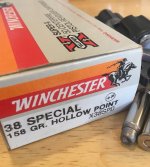From what I have researched any bullet that does well in the 4LD FBI calibrated gel tests, does well on the street.
The 4LD isn't to simulate clothing, but simulate worst case plugging and the Synthetic gel usually gives erratic and exaggerated results.
Bottom line I wouldn't want to be shot period. But with a pistol round being marginal, and the human body being robust, it only makes sense to carry and shoot the best bullets available. If you practice one handed, two handed, stationary, on the move and become proficient with what you carry shot placement is the most important thing anyway. I think people get too tied up in gel tests. Expanded or not a 158gr to the CNS is a 158gr to the CNS.
You're referencing four layer denim testing like it is actually an FBI protocol. It isn't. I'm not sure who started substituting 4 layers of denim, and I'm not sure who started calling that the FBI protocol, but it simply isn't.
.../
/...A note of question about current FBI test protocol. I read somewhere that the FBI does not use 4 layers of denim but rather 1 layer of denim, 2 layers of T-shirt and 1 layer of sweatshirt. Does anyone know for sure?
Also it appears that most You Tube Testers use 4 layers of brand hew very stiff denim which I would think would be much tougher than say, 2-3 year old stone washed denim.
The FBI's Heavy Clothing barrier is designed to actually reflect heavy winter clothing and consists of:
(1) layer of Denim (14.4 ounces/yard, 50 threads per inch);
(1) layer of Polartec 200 fleece;
(1) layer of cotton dress shirt (3.5 ounces/yard, 80 threads per inch); and
(1) cotton T-shirt (5.25 ounces/yard, 48 threads per inch) layered firmly on the face of the ballistic gelatin block.
It's intended to mimic a coat with a durable wind resistant layer and underlying insulation, along with a shirt and a tee shirt.
It's not the same as the four layer denim test, and the results of 4 layers of denim plugging a hollow point don't necessarily generalize to how well that same hollow point might perform with the 4 layers actually used by the FBI. Yet shooters swear by the 4LD test as they think it is an "FBI" protocol.
As an aside, the FBI switched from down to Polartec in 2004 to reduce the variability that was created by down fill.
----
The full protocol starts with bare calibrated gelatin, which has results that are not significantly different than Light Clothing (a cotton undershirt and a linen dress shirt). If a bullet doesn't expand here it's not going to perform in the later tests.
Steel penetration protocols are designed mimic a car door. The FBI Steel fixture simulates the thinnest part of a car door with no intervening gears, motors, handles, stiffeners, etc. It consists of two pieces of 20 gauge sheet steel placed 3" apart. The gelatin is placed 18" behind the car door fixture and is covered in light clothing (the cotton T-shirt and linen dress shirt). The gel block simulates an adversary who is shooting from behind a car door. Conventional handgun bullets which impact this material usually end up with a flattened nail head appearance which slightly increases the expanded diameter of the bullet, but prevents any further expansion.
The FBI wall board protocol simulates penetration in a residential wall. I'm not sure why, but the FBI uses two pieces of .5" drywall spaced 3.5" apart to simulate a wall when it's common to use 1/2" drywall on ceilings and either 5/8" on walls as it's more durable, or 3/4" as it has a better fire rating. it's backed up by the same gel block covered in Light Clothing.
The plywood protocol partially simulates an exterior wall. Interestingly, the FBI just uses a single sheet of 3/4" AA fir plywood, rather than also using a spaced layer of 1/2" dry wall, and it doesn't incorporate any siding material. A single sheet does eliminate the directionality issue, but it also isn't reflective of much more than a single layer garage or shed wall with no siding. Still, it's a useful test as a bullet that will reliably expand in 3/4" plywood will almost always expand well in dry wall and heavy clothing.
The auto glass protocol uses a 1/4" thick 15"x18" AS1 laminated safety glass panel with a Light Clothing covered ballistic gel block aced 18" behind the glass panel. The panel is angled 45 degrees from the vertical and 15 degrees to the side to create a compound angle to simulate a shot taken at the driver from the left front quarter. There is once again a Light Clothing covered gel block 18" behind the panel.
The FBI uses 5 shots in each test, scores each shot, and scores each shot.
They score penetration and consistency in penetration:
Expansion:
and Retained weight:
The FBI then averages the scores for all five rounds in each of the tests and scored criteria and applies three formulas using the average scores to get a point total.
Penetration:
(((Penetration Score x Penetration Standard Deviation Score) x .5) + (Shots under 12" score x 0.2)) x50) = Penetration Points
Expansion:
(average point value x 0.2) x 50 = Expansion Points
and Weight Retention:
(average point value x 0.1) x 50 = Weight Retention Points
The FBI adds the three sub totals together to award a final point score out of 500 possible points. Given the narrow ranges for maximum points in penetration, expansion and weight retention, and the emphasis placed on consistency, even the best loads currently being made will only score around 250 points.




